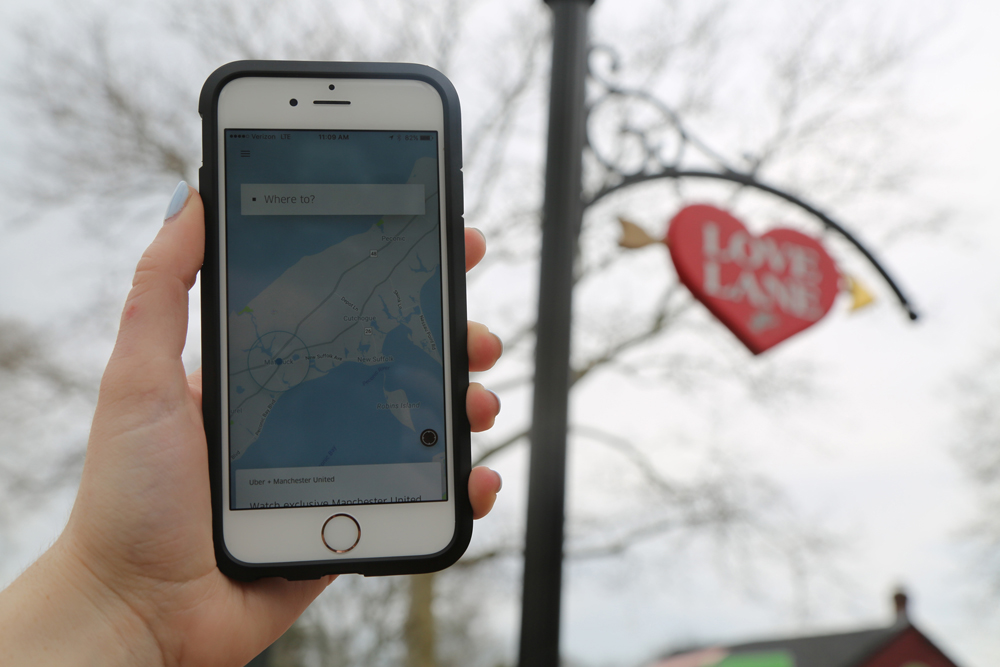As ride-hailing apps like Uber become more popular, North Fork lags behind

Transportation has long been a topic of discussion on the North Fork, whether it’s about offering the public ways to get around or managing tourism volume in the busier seasons.
App-based ride-hailing services like Uber and Lyft are now permitted to operate throughout New York State, but local business owners and officials noted that, while the region can benefit from such services, a consistent pool of drivers is not yet available for them to be widely reliable here.
As of late June 2017, New York began regulating ride-hailing statewide through the Department of Motor Vehicles. The related legislation set requirements for drivers, such as criminal backgrounds checks, and allows the state to collect a 4 percent assessment fee on trips beginning outside New York City. The fee goes into the state’s general fund.
A six-month moratorium on ride-hailing services was recently floated in the Suffolk County Legislature by Legislator Bridget Fleming (D-Sag Harbor) so that the county could find a way to receive a portion of the surcharge to put toward bus services that have been scaled back. The Legislature tabled the proposal in early March.
Riverhead Town Supervisor Laura Jens-Smith said she’d like revenues from any tax to stay more local, but that any new form of transportation in the area is helpful. It’s a challenge to get from place to place in the region without driving, she said. She also said the current issue with ride-hailing locally is reliability.
“If you get an Uber or Lyft ride out here, are you going to be able to get an Uber or Lyft ride back?” she asked.
Mike Falcetta, general manager of Sparkling Pointe Vineyards & Winery in Southold, said some customers have used the services, but that they’d be used more if they were more accessible.
“The availability is very sporadic and not consistent,” he said.
 Southold Town Supervisor Scott Russell said another challenge the community faces is getting people around once they’re out here.
Southold Town Supervisor Scott Russell said another challenge the community faces is getting people around once they’re out here.
“We have lobbied for expanded LIRR service to Southold and have had some success,” he said. “Great, we get them to take a train. Now, what do we do with them once they are here?”
Services like Uber can help fill that need, he said, noting that Southold’s attractions are scattered throughout the town or in locations that aren’t so easy to get to. Traditional cabs are currently difficult to find and can be costly, he added.
Mr. Russell also said app-based services can assist locals who perhaps don’t have licenses or can no longer drive and rely on others to get to doctor’s appointments or to work.
“Moving tourists around is great,” he said. “Getting local residents to where they need to be, and at a cost that’s manageable, is even better.”
Services like Uber and Lyft are needed and will complement existing taxis services in the region, said Duncan Kennedy, president of the North Fork Promotion Council president and operator of the Duncan Inn in Jamesport. It’s not uncommon for consumers to be in Jamesport in the afternoon and Greenport in the evening, he said.
“From my experiences, we appear to be at the point where there is not enough usage, as there are not enough drivers,” he said. “Hopefully, market forces will correct this [in the] coming busy season.”
Lyft communications manger Campbell Matthews said the company is committed to offering transportation throughout Long Island, particularly during the busy summer season.
“We’re thrilled to be available to passengers who are frequenting the North Fork, and to provide earning opportunities for those who drive with Lyft,” Mr. Matthews said. “In the coming months, we are looking forward to partnering with local businesses and events to ensure that we are facilitating the most seamless transportation to and from the area.”
Traditional cab services have been less available over the years, as it can be costly to run a small company, said Benjamin Heins, who ran a transportation company that served Southold and Shelter Island from 2001 to 2011.
“What did us in was two different factors,” he said “The first was the insurance.”
Cab companies have to pay for-hire insurance for each car they operate. Mr. Heins said that cost around $1,500 per car each year, but that the cost went up every year and insurance companies added more requirements. The upside for Uber drivers, he said, is that they can have regular insurance on their cars and are covered by the company’s liability insurance.
At the same time, demographics on the North Fork were changing as housing costs rose and the younger crowd moved away, Mr. Heins said. Summers were still busy, but year-round business fell, he said. Additionally, as younger people left the area, it was harder to find people looking for part-time jobs as drivers, he said.
In the winters, the bar trade was the “bread-and-butter” for cab services, Mr. Heins said. Ride-hailing could be fully embraced if bartenders and restaurant owners can call Uber or Lyft for their customers, he said.
“If there’s a way to fill that gap in, it would vastly improve things because bartenders out here are incredibly conscientious about people getting home safely,” he said.
Photo caption: A cell phone with the Uber app displayed in Mattituck. (Credit: Kelly Zegers)









